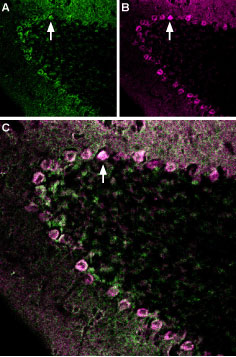Overview
- Peptide (C)KPRHQKDAKHPQMIK, corresponding to amino acid residues 546-560 of rat Neurexin 1α (Accession Q63372). Extracellular, N-terminus.
- Rat brain sections.
 Multiplex staining of Neurexin 1α and GABA(A) ε Receptor in mouse cerebellumImmunohistochemical staining of rat cerebellum frozen section using Anti-Neurexin 1α (extracellular)-ATTO Fluor-488 Antibody (#ANR-031-AG) and Anti-GABA(A) ε Receptor (GABRE) (extracellular)-ATTO Fluor-633 Antibody (#AGA-015-FR). A. Nrxn1α staining (green). B. GABA(A) ε receptor staining (purple). C. Merge of the two images suggests extensive co-localization in Purkinje cells (arrow).
Multiplex staining of Neurexin 1α and GABA(A) ε Receptor in mouse cerebellumImmunohistochemical staining of rat cerebellum frozen section using Anti-Neurexin 1α (extracellular)-ATTO Fluor-488 Antibody (#ANR-031-AG) and Anti-GABA(A) ε Receptor (GABRE) (extracellular)-ATTO Fluor-633 Antibody (#AGA-015-FR). A. Nrxn1α staining (green). B. GABA(A) ε receptor staining (purple). C. Merge of the two images suggests extensive co-localization in Purkinje cells (arrow).
Neurexins (NRXNs) are a family of transmembrane, synaptic adhesion molecules. NRXNS were identified as receptors for α-latrotoxin, a presynaptic toxin that triggers massive neurotransmitter release1. Neurexins are largely presynaptic proteins that form a trans-synaptic cell-adhesion complex with postsynaptic neuroligins2. They are encoded by three genes (NRXN1, NRXN2 and NRXN3), each using an upstream promoter to produce the longer α-isoform (α-NRXNs) and a downstream promoter to generate a shorter β-isoform (β- NRXNs).
The α- and β-isoforms of each neurexin are single-pass transmembrane proteins maintaining identical transmembrane and intracellular domains but having distinct extracellular domains. NRXNs in neurons localize to the presynaptic membrane and bind trans-synaptically to postsynaptic adhesion molecules and receptors3. Neurexins are expressed in all neurons, and are subject to extensive alternative splicing, generating >1,000 splice variants, some of which exhibit highly regulated developmental and spatial expression patterns4.
The extracellular domain of neurexin 1α (NRXN1α) is composed of three neurexin repeats (I, II, and III), which each contains the modules LNS-EGF-LNS. NRXN1α binds endogenous ligands including neuroligins, LRRTM family members, neurexophilin, α-dystroglycan, and GABA(A) receptors.
NRXN1α gene mutations have been identified in neuropsychiatric diseases including Schizophrenia and Autism Spectrum Disorder5.
